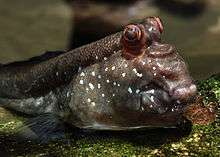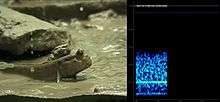Mudskipper
| Mudskippers | |
|---|---|
 | |
| Mudskippers in The Gambia | |
| Scientific classification | |
| Kingdom: | Animalia |
| Phylum: | Chordata |
| Superclass: | Osteichthyes |
| Class: | Actinopterygii |
| Superorder: | Acanthopterygii |
| Order: | Perciformes |
| Suborder: | Gobioidei |
| Family: | Gobiidae |
| Subfamily: | Oxudercinae |
| Genera | |
|
Apocryptes | |
| Synonyms | |
| |
Mudskippers are fish of the subfamily Oxudercinae (tribe Periophthalmini),[1] within the family Gobiidae (gobies). The subfamily includes about 41 species. They are completely amphibious fish that can use their pectoral fins to walk on land.[2][3] Being amphibious, they are uniquely adapted to intertidal habitats, unlike most fish in such habitats which survive the retreat of the tide by hiding under wet seaweed or in tidal pools.[4]
Mudskippers are quite active when out of water, feeding and interacting with one another, for example, to defend their territories. They are found in tropical, subtropical, and temperate regions, including the Indo-Pacific and the Atlantic coast of Africa.
Adaptations

Compared with fully aquatic gobies, these fish present a range of peculiar behavioural and physiological adaptations to an amphibious lifestyle. Anatomical and behavioural adaptations that allow them to move effectively on land as well as in the water:[3] As their name implies, these fish use their fins to move around in a series of skips. They can also flip their muscular bodies to catapult themselves up to 2 ft (60 cm) into the air.[5]
| “ | Although mudskippers’ fins do not have a joint homologous to the elbow, the joint between the radials and the fin rays serves a functionally analogous role. | ” | |
| “ | The mudskipper pectoral fin differs from most actinopterygian fishes in that the radials of the mudskipper pectoral fin are elongate and protrude from the body wall. This unusual morphology creates a pectoral fin with two fin segments (the radials and the rays) and two movable hinge joints: a `shoulder' joint where the cleithrum meets the radials and a `intra-fin' joint where the radials meet the rays (Harris, 1959). In addition, [...] the abductor superficialis muscle of the pectoral fin is divided into two sections (rather than being a single muscle, as is common with the rest of the Oxudercinae gobies) with one section inserting on the dorsal rays and the other section inserting on the ventral rays (Murdy, 1989). | ” | |
Mudskippers have the ability to breathe through their skin and the lining of their mouth (the mucosa) and throat (the pharynx): This is only possible when the mudskippers are wet, limiting them to humid habitats and requiring they keep themselves moist. This mode of breathing, similar to that employed by amphibians, is known as cutaneous air breathing.[4] Another important adaptation that aids breathing while out of water is their enlarged gill chambers, where they retain a bubble of water. These chambers close tightly when the fish is above water, keeping the gills moist, and allowing them to function. They act like a scuba diver's cylinders, and supply oxygen for respiration also while on land.[4]
Digging deep burrows in soft sediments allow the fish to thermoregulate,[8] avoid marine predators during the high tide when the fish and burrow are submerged,[9] and lay their eggs.[10]
Even when its burrow is submerged, a mudskipper maintains an air pocket inside it, which allows it to breathe in conditions of very low oxygen concentration.[11][12][13]
Species
.webm.jpg)

The genus Periophthalmus is by far the most diverse and widespread genus of mudskipper. Eighteen species have been described.[14][15][16] Periophthalmus argentilineatus is one of the most widespread and well-known species. It can be found in mangrove ecosystems and mudflats of East Africa and Madagascar east through the Sundarbans of Bengal, Southeast Asia to Northern Australia, southeast China, and southern Japan, to Samoa and Tonga Islands.[1] It grows to a length of about 9.5 cm [1] and is a carnivorous opportunist feeder. It feeds on small prey such as small crabs and other arthropods.[17] Another species, Periophthalmus barbarus, is the only oxudercine goby that inhabits the coastal areas of western Africa.[1]
See also
References
- 1 2 3 4 Murdy EO (1989). "A Taxonomic Revision and Cladistic Analysis of the Oxudercine Gobies (Gobiidae: Oxudercinae)". Records of the Australian Museum. Suppl 11: 1–93. doi:10.3853/j.0812-7387.11.1989.93.
- ↑ Swanson BO, Gibb AC (2004). "Kinematics of aquatic and terrestrial escape responses in mudskippers" (PDF). The Journal of Experimental Biology 207 (Pt 23): 4037–44. doi:10.1242/jeb.01237. PMID 15498949.
- 1 2 Harris VA (1960). "On the locomotion of the mudskipper Periophthalmus koelreuteri (Pallas): Gobiidae". Proceedings of the Zoological Society of London 134: 107–35. doi:10.1111/j.1469-7998.1960.tb05921.x.
- 1 2 3 Graham JB, ed. (1997). Air–breathing Fishes. Evolution, Diversity and Adaptation. San Diego California: Academic Press.
- ↑ Piper R (2007). Extraordinary Animals: An Encyclopedia of Curious and Unusual Animals. Greenwood Press.
- ↑ S. M. Kawano and R. W. Blob (August 2, 2013). "Propulsive Forces of Mudskipper Fins and Salamander Limbs during Terrestrial Locomotion: Implications for the Invasion of Land" (PDF). Integrative and Comparative Biology 53: 283–294. doi:10.1093/icb/ict051. PMID 23667046.
- ↑ C. M. Pace and A. C. Gibb (July 15, 2009). "Mudskipper pectoral fin kinematics in aquatic and terrestrial environments" (PDF). The Journal of Experimental Biology 212: 2279–2286. doi:10.1242/jeb.029041. PMID 19561218.
- ↑ Tytler P, Vaughan T (1983). "Thermal Ecology of the Mudskippers Periophthalmus koelreuteri (Pallas) and Boleophthalmus boddaerti (Pallas), of Kuwait Bay". Journal of Fish Biology 23 (3): 327–37. doi:10.1111/j.1095-8649.1983.tb02912.x.
- ↑ Sasekumar A, Chong VC, Lim KH, Singh HR (1994). "The Fish Community of Matang Mangrove Waters, Malaysia". In Sudara S, Wilkinson CR, Chou LM. Proceedings, Third ASEAN-Australia Symposium on Living Coastal Resources. Research papers. Bangkok: Chulalonghorn University. pp. 457–64.
- ↑ Brillet C (1969). "Etude du comportement constructeur des poissons amphibies Periophthalmidae". Terre et la Vie (in French) 23 (4): 496–520.
- ↑ Ishimatsu A, Hishida Y, Takita T, Kanda T, Oikawa S, Takeda T, Khoo KH (1998). "Mudskipper Store Air in Their Burrows". Nature 391 (6664): 237–8. doi:10.1038/34560.
- ↑ Ishimatsu A, Takeda T, Kanda T, Oikawa S, Khoo KH (2000). "Burrow environment of mudskippers in Malaysia". Journal of Bioscience 11 (1–2): 17–28.
- ↑ Lee HJ, Martinez CA, Hertzberg KJ, Hamilton AL, Graham JB (2005). "Burrow air phase maintenance and respiration by the mudskipper Scartelaos histophorus (Gobiidae: Oxudercinae)". The Journal of Experimental Biology 208 (Pt 1): 169–77. doi:10.1242/jeb.01361. PMID 15601887.
- ↑ Larson HK, Takita T (2004). "Two new species of Periophthalmus (Teleostei: Gobiidae: Oxudercinae) from northern Australia, and a re-diagnosis of Periophthalmus novaeguineaensis". The Beagle, Records of the Museums and Art Galleries of the Northern Territory 20: 175–85.
- ↑ Jaafar Z, Perrig M, Chou LM (2009). "Periophthalmus variabilis (Teleostei: Gobiidae: Oxudercinae), a valid species of mudskipper, and a re-diagnosis of Periophthalmus novemradiatus". Zoological Science 26 (4): 309–14. doi:10.2108/zsj.26.309. PMID 19798926.
- ↑ Jaafar Z, Larson HL (2008). "A new species of mudskipper, Periophthalmus takita (Teleostei: Gobiidae: Oxudercinae), from Australia, with a key to the genus". Zoological Science 25 (9): 946–52. doi:10.2108/zsj.25.946. PMID 19267605.
- ↑ Milward, NE (1974). Studies on the taxonomy, ecology and physiology of Queensland mudskippers (unpubl. Ph.D. dissertation ed.). Brisbane: University of Queensland.
External links
| Wikimedia Commons has media related to Oxudercinae. |
- FishBase entry on Gobiidae
- Gobioid Research Institute
- Mudskipper Page for aquarists
- The Mudskipper: a website on mudskippers or The Mudskipper
- Fish out of Water: Qatar Mudskippers
- Giant Mudskippers - Periophthalmodon schlosseri
- Mudskipper photos by Daniel Trim
